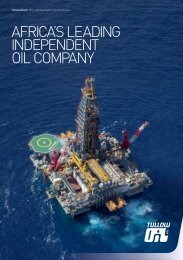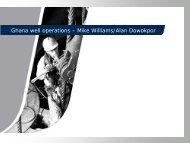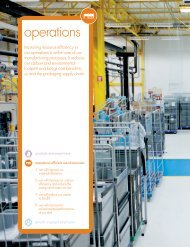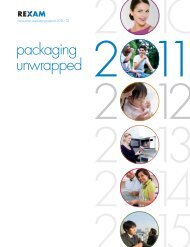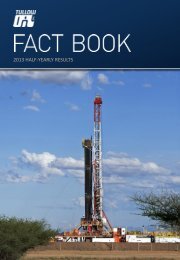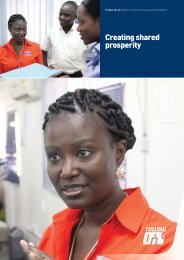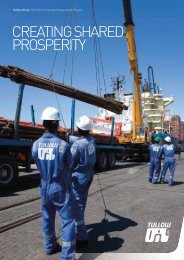Annual report 2010 - Imperial Tobacco Group
Annual report 2010 - Imperial Tobacco Group
Annual report 2010 - Imperial Tobacco Group
Create successful ePaper yourself
Turn your PDF publications into a flip-book with our unique Google optimized e-Paper software.
InventoriesInventories are stated at the lower of cost and net realisable value. Cost is determined using the first-in, first-out (FIFO)method. The cost of finished goods and work in progress comprises raw materials, direct labour, other direct costs andrelated production overheads (based on normal operating capacity) but excludes borrowing costs. Net realisable value isthe estimated selling price in the ordinary course of business, less the estimated costs of completion and selling expenses.Leaf tobacco inventory which has an operating cycle that exceeds twelve months is classified as a current asset, consistentwith recognised industry practice.ProvisionsA provision is recognised in the balance sheet when the <strong>Group</strong> has a legal or constructive obligation as a result of a pastevent, it is more likely than not that an outflow of resources will be required to settle that obligation, and a reliable estimateof the amount can be made.A provision for restructuring is recognised when the <strong>Group</strong> has approved a detailed formal restructuring plan, and therestructuring has either commenced or has been publicly announced, and it is more likely than not that the plan will beimplemented, and the amount required to settle any obligations arising can be reliably estimated. Future operating lossesare not provided for.Where there are a number of similar obligations, the likelihood that an outflow will be required in settlement is determined byconsidering the class of obligations as a whole. A provision is recognised even if the likelihood of an outflow with respect toany one item included in the same class of obligations may be small.Retirement Benefit SchemesThe <strong>Group</strong> operates a number of retirement benefit schemes for its employees, including both defined benefit and definedcontribution schemes.Under a defined benefit scheme, the amount of retirement benefit that will be received by an employee is defined withrespect to period of service and final salary. The amount recognised in the balance sheet is the difference between thepresent value of the defined benefit obligation at the balance sheet date and the fair value of the scheme assets. The definedbenefit obligation is calculated annually by independent actuaries using the projected unit credit method. The present valueof the defined benefit obligation is determined by discounting the estimated future cash outflows.The service cost of providing retirement benefits to employees during the year is charged to operating profit.Past service costs are recognised immediately in income, unless the changes to the pension plan are conditional on theemployees remaining in service for a specified period of time (the vesting period). In this case, the past service costs areamortised on a straight line basis over the average vesting period. All actuarial gains and losses, including differencesbetween actual and expected returns on assets and differences that arise as a result of changes in actuarial assumptions,are recognised immediately in full in the statement of comprehensive income for the period in which they arise.A credit representing the expected return on plan assets of the retirement benefit schemes during the year is included withinnet finance costs. This is based on the market value of the assets of the schemes at the start of the financial year. A chargeis also made within net finance costs for the expected increase in the present value of the liabilities of the retirement benefitschemes during the year arising from the schemes being one year closer to payment.For defined contribution schemes, the <strong>Group</strong> pays a defined contribution to the scheme. There are no further paymentobligations once these contributions have been paid. Such contributions are recognised as an employee benefit expensewhen they are due. Any prepaid contributions are recognised as an asset to the extent that a cash refund or reduction infuture payments is available.Share-Based PaymentsThe <strong>Group</strong> applies the requirements of IFRS 2 Share-Based Payment Transactions to both equity-settled and cash-settledshare-based employee compensation schemes. The majority of the <strong>Group</strong>’s schemes are equity-settled.Equity-settled share-based payments are measured at fair value at the date of grant and are expensed over the vestingperiod, based on the number of instruments that are expected to vest. For plans where vesting conditions are based on totalshareholder returns, the fair value at the date of grant reflects these conditions. Earnings per share vesting conditions arereflected in the estimate of awards that will eventually vest. For cash-settled share-based payments, a liability equal to theportion of the services received is recognised at its current fair value at each balance sheet date. Where applicable the <strong>Group</strong>recognises the impact of revisions to original estimates in the income statement, with a corresponding adjustment to equityfor equity-settled schemes and current liabilities for cash-settled schemes. Fair values are measured using appropriatevaluation models, taking into account the terms and conditions of the awards.The <strong>Group</strong> funds the purchase of shares to satisfy rights to shares arising under share-based employee compensationschemes. Shares acquired to satisfy those rights are held in Employee Share Ownership Trusts. On consolidation, theseshares are accounted for as a deduction from equity attributable to owners of the parent. When the rights are exercised,equity is increased by the amount of any proceeds received by the Employee Share Ownership Trusts.107



